My thanks to Jerry Harris, who gave me a copy of the Nexus file
from his (2006) analysis. My file is based on his, changed only in
splitting the compound "Brachiosaurus" OTU.
|
FIGURE 1.
Dorsal vertebrae of Brachiosaurus altithorax
and Brachiosaurus brancai in posterior and lateral views,
equally scaled. A, B, E, F, I,
J, M, N, B. altithorax holotype
FMNH P 25107, modified from Riggs
(1904:pl. LXXII); C, D, G,
H, K, L, O, P, B. brancai
lectotype HMN SII, modified from Janensch (1950a:figs. 53, 54, 56,
60-62, 64) except H, photograph by author. Neural arch and
spine of K sheared to correct for distortion. A,
D, E, H, I, L, M, P,
posterior; B, F, G, J, N, right
lateral; C, K, O, left lateral
reflected. A, B, dorsal 6; C, D, dorsal
4; E-H, dorsal 8; I-L, dorsal
10; M, N, P, dorsal 12; O, dorsals 11 and
12. Corresponding vertebrae from each specimen are shown together
except that dorsal 4 is not known from B. altithorax so
dorsal 6, the most anterior known vertebra, is instead shown next to
dorsal 4 of B. brancai. Scale bar equals 50 cm.
|

|
|
FIGURE 2.
Sacra of Brachiosaurus altithorax and Brachiosaurus
brancai, equally
scaled. A, B, B. altithorax holotype FMNH
P 25107; C, B. brancai referred specimen HMN Aa; D, juvenile
B. brancai referred specimen HMN T. A, C, right lateral;
B, D, ventral. A, B modified from Riggs
(1904:pl. LXXIII); C, D modified from Janensch (1950a:
figs. 74 and 76). Scale bar equals 50 cm.
|
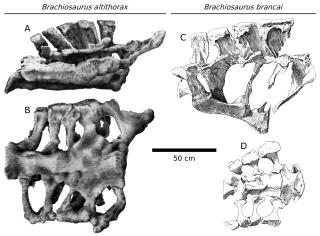
|
|
FIGURE 3.
Second caudal vertebrae of Brachiosaurus altithorax
and Brachiosaurus brancai, equally
scaled. A, B, B. altithorax holotype FMNH
P 25107;
C-G, B. brancai referred specimen HMN
Aa. A, C, posterior; B, D, F, right
lateral; E, G, anterior. A-B modified from
Riggs (1904:pl. LXXV); C-E modified from Janensch
(1950a:pl. 2), F-G modified from Janensch
(1929:fig. 15). Scale bar equals 50 cm. 3
|
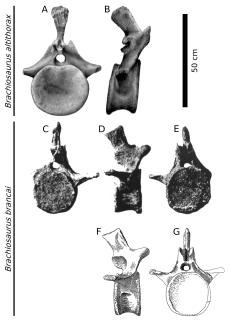
|
|
FIGURE 4.
Limb girdle bones of Brachiosaurus altithorax
and Brachiosaurus brancai, equally scaled. A, C,
right ilium of B. altithorax holotype FMNH P
25107; B, D, left coracoid of same, reflected; E,
right ilium of B. brancai referred specimen Aa 13,
scaled to size of restored ilium of B. brancai lectotype
HMN SII as estimated by Janensch (1950b:99); F, right coracoid
of B. brancai lectotype HMN SII. A modified from
FMNH neg. #GEO-16152, showing poor preservation and absence of public
peduncle; B modified from Riggs
(1903:fig. 3); C, D modified from Riggs
(1904:pl. LXXV); E modified from Janensch (1961:Beilage E,
fig. 1a); F modified from Janensch (1961:fig. 1a). Scale bar
equals 50 cm.
|
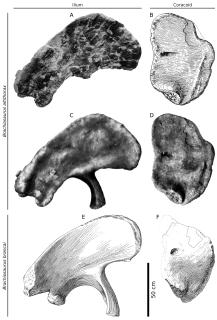
|
|
FIGURE 5.
Right limb bones of Brachiosaurus altithorax
and Brachiosaurus brancai, equally scaled. A-C,
humerus of B. altithorax holotype FMNH P
25107; D-F, femur of same; G-K, humerus
of B. brancai lectotype HMN SII; L-P,
femur of B. brancai referred specimen HMN St 291, scaled
to size of restored femur of HMN SII as estimated by Janensch
(1950b:99). A, D, G, L,
proximal; B, E, H, M,
anterior; C, K,
P, posterior; J, O,
medial; F, I, N,
distal. A, B, D, E modified from Riggs
(1904:pl. LXXIV); C modified from Riggs (1904:fig. 1); F
modified from Riggs (1903:fig. 7); G-K modified from
Janensch (1961:Beilage A); L-P modified from Janensch
(1961:Beilage J). Scale bar equals 50 cm.
|

|
|
FIGURE 6. Phylogenetic relationships of Brachiosaurus and
Giraffatitan, produced using PAUP* 4.0b10 on the matrix of Harris
(2006) modified by splitting the composite "Brachiosaurus" OTU
into two separate OTUs for the two species, having 31 taxa and 331
characters. Strict consensus of 72 most parsimonious trees (length =
791; CI = 0.5196; RI = 0.6846, RC = 0.3557). Three clades forming a
node-stem triplet are highlighted: the node-based Titanosauriformes,
and the branch-based sister clades Brachiosauridae and Somphospondyli.
|
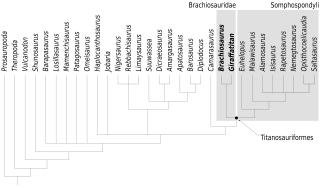
|
|
FIGURE 7.
Skeletal reconstruction of Brachiosaurus altithorax. White
bones represent the elements of the holotype FMNH P 25107. Light grey
bones represent material referred to B. altithorax: the
Felch Quarry skull USNM 5730, the cervical vertebrae BYU 12866 (C?5)
and BYU 12867 (C?10), the "Ultrasauros" scapulocoracoid BYU
9462, the Potter Creek left humerus USNM 21903, left radius and right
metacarpal III BYU 4744, and the left metacarpal II OMNH 01138. Dark
grey bones modified from Paul's (1988) reconstruction
of Giraffatitan brancai. Scale bar equals 2 m.
|
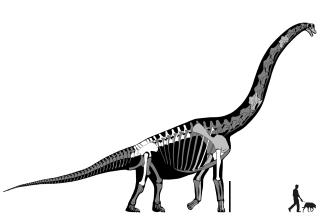
|






